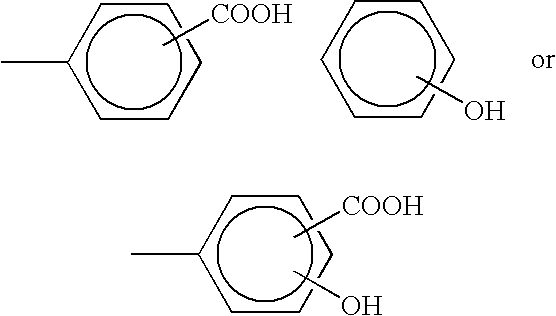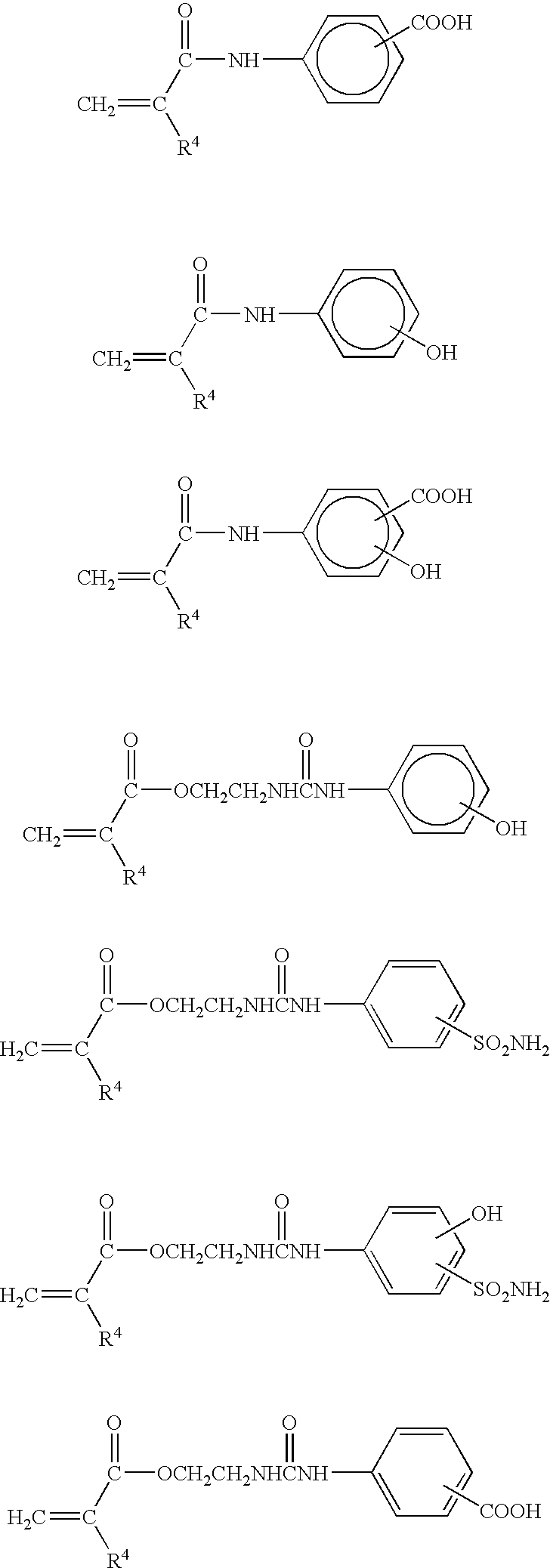Lithographic-printing plate precursor and image forming method using the same
- Summary
- Abstract
- Description
- Claims
- Application Information
AI Technical Summary
Benefits of technology
Problems solved by technology
Method used
Image
Examples
synthesis example 1
[0078]In a 500 ml three-necked round bottom flask equipped with a concentrator and a stirrer, 2.7 g of 4,4′-diphenylmethane diisocyanate, 14.5 g of toluene-2,4-diisocyanate, 7.0 g of neopentyl glycol, 35.8 g of 2,2-bis(hydroxymethyl)propionic acid and 280 g of 3-pentanone were charged. After adding 0.3 g of dibutyltin didodecanoate, the reaction mixture was heated to 80° C. while stirring. The reaction was continued at 80° C. for 6 hours. Thus, a polyurethane (1) was obtained. A weight average molecular weight as determined by GPC was 24,000. An acid value was 125.
synthesis examples 2 to 9
[0079]In the same manner as in Synthesis Example 1, except that diisocyanates and diols shown in Table 1, polyurethanes (2) to (9) were obtained.
TABLE 1Diisocyanates and diols of Synthesis Examples 2 to 9No.DiisocyanatesratioDiolsratio(2)diisocyanate:diol = 1.5:1, molecular weight: 7,000(3)75 mol %25 mol %diisocyanate:diol = 1:1.2, molecular weight: 12,000(4)75 mol %80 mol %25 mol %20 mol %diisocyanate:diol = 1:1.1, molecular weight: 17,000(5)80 mol %20 mol %diisocyanate:diol = 1:1, molecular weight: 23,000(6)75 mol %75 mol %25 mol %25 mol %diisocyanate:diol = 1:1, molecular weight: 25,000(7)85 mol %HO—(CH2)6—OH15 mol %diisocyanate:diol = 1:1.05, molecular weight: 20,000(8)75 mol %80 mol %OCN—(CH2)6—NCO25 mol %20 mol %diisocyanate:diol = 1:1.05, molecular weight: 19,000(9)80 mol %85 mol %20 mol %15 mol %diisocyanate:diol = 1:1.1, molecular weight: 18,000
example 1
Substrate
[0080]The surface of an aluminum sheet was subjected to an electrolytic roughening treatment using 2% hydrochloric acid. An average roughness Ra was 0.5 μm. Furthermore, the aluminum sheet was subjected to an anodizing treatment in an aqueous 20% sulfuric acid solution to form 2.7 g / m2 of an oxide film. The anodized aluminum sheet was dipped in an aqueous 2.5% sodium silicate at 70° C. for 30 minutes, washed with water and then dried.
(Image Recording Layer)
[0081]On the substrate thus obtained, a coating solution 1 for a lower layer shown in Table 2 was coated in a coating weight of 1.5 g / m2 using a bar coater, followed by drying at 130° C. for 40 seconds and further cooling to 35° C. Furthermore, a coating solution 1 for an upper layer shown in Table 3 was coated in a coating weight of 0.5 g / m2 using a bar coater, followed by drying at 135° C. for 40 seconds and further slow cooling to a temperature of 20 to 26° C. Thus, a lithographic printing plate precursor was obtained....
PUM
| Property | Measurement | Unit |
|---|---|---|
| Percent by mass | aaaaa | aaaaa |
| Percent by mass | aaaaa | aaaaa |
| Acidity | aaaaa | aaaaa |
Abstract
Description
Claims
Application Information
 Login to View More
Login to View More - R&D
- Intellectual Property
- Life Sciences
- Materials
- Tech Scout
- Unparalleled Data Quality
- Higher Quality Content
- 60% Fewer Hallucinations
Browse by: Latest US Patents, China's latest patents, Technical Efficacy Thesaurus, Application Domain, Technology Topic, Popular Technical Reports.
© 2025 PatSnap. All rights reserved.Legal|Privacy policy|Modern Slavery Act Transparency Statement|Sitemap|About US| Contact US: help@patsnap.com



